Equality objectives progress review 2020 to 2021
Updated 31 May 2023
Applies to England
Introduction
This report is a review of our progress against our 2020–22 equality objectives. It covers the period April 2020 to March 2021.
The objectives relate to how we inspect and regulate, and our practice as an employer and contractor. As a result, this report does not include what we found in our inspection, regulatory and research work. We report on our findings through individual inspection reports, research and evaluation reports, commentaries, blogs and Annual Reports.
The 2020–21 reporting year was, of course, a very different year for everyone because of the pandemic. For Ofsted, routine inspection was paused in March 2020, although we continued to carry out our regulatory work and urgent inspections.
During this period, we considered carefully how our skills and resources could best support the national effort. As a result, we deployed hundreds of staff to help central government, local authorities and providers. As soon as government guidance allowed, in autumn 2020, we started visiting nurseries, schools, colleges, further education and skills providers and children’s social care providers to look at what was going well and what needed to improve. We gathered insights from these visits and published research to inform government policy and to help those sectors to improve.
Our work to develop the way we inspect continued throughout the year. We published a new inspection framework for initial teacher education (ITE) and have been developing an approach to quality assuring the early career framework (ECF) and reformed national professional qualifications (NPQs). We are also developing a new framework for inspecting special educational needs and disabilities (SEND) provision in a local area from 2022. In all these developments, we have taken account of our public sector equality duties (PSED) and our wider equality objectives.
During the year, we also supported our staff to work differently because of the pandemic. We worked with our staff networks, unions and teams, and carried out surveys to understand staff well-being and to respond to any concerns. This year, we have focused particularly on doing all we can to reduce bullying, harassment and discrimination.
Over the next year, we intend to review our equality objectives alongside the development of our new strategy and the forthcoming publication of the government’s new diversity and inclusion strategy.
This has been a difficult year for everyone. We therefore made sure that, whatever activity we were carrying out, we considered our obligations under the PSED and the impact we have on those we inspect and those who use their services.
Objective 1
Ofsted will give due regard to equality, diversity and inclusion during inspection and in its research and evaluation work
This objective is broken down into 2 parts. The numbering relates to that within our 2020–22 equality objectives.
1.1 In making judgements, inspectors will assess whether those we inspect and/or regulate comply with their relevant duties under the Equality Act 2010 and, where applicable, the extent to which they promote British values and promote equality and diversity.
1.2 Where meaningful, we will comment on outcomes for children and learners with relevant protected characteristics and we will continue our programme of local area special educational needs and disabilities (area SEND) (formerly LA SEND) inspections.
Actions
Our actions are to:
- be clear in all published inspection frameworks that inspectors will take the above factors into account
- provide training to inspectors on equality, diversity and inclusion, and how to evaluate these areas on inspection
- ensure that we consider those with protected characteristics when setting and carrying out our research and analysis programmes
Success criterion
Inspectors report non-compliance with the Equality Act 2010 when encountered.
Update on objective 1 action: Be clear in all published inspection frameworks that inspectors will take the above factors into account
Developing and delivering interim visits
Routine inspection was paused in March 2020 because of COVID-19. As soon as government guidance allowed, in autumn 2020, we carried out a range of ungraded interim visits before resuming some routine inspection. We published national findings from our interim visits in a series of monthly COVID-19 briefings throughout the autumn term. The reports and briefings gave the public and government real-time information about the impact of COVID-19 on the sectors we inspect and regulate.
When developing the approach to interim visits for each inspection remit, we considered the equality, diversity and inclusion implications, including the aims of the PSED, in relation to:
- early years providers, schools, and further education and skills providers
- SEND provision in local areas
- social care providers and local authorities
Early years providers, schools, and further education and skills providers
Inspectors looked at how the needs of children and learners were being met. They raised any significant concerns, including any concerns relating to particular groups of children and learners, with leaders and the appropriate authorities.
SEND provision in local areas
We worked closely with the Care Quality Commission to deliver a programme of visits to local areas. We knew that the impact of COVID-19 was likely to have been significant for children with SEND, especially those from some minority groups.
Social care providers and local authorities
In addition to continuing to carry out children’s social care regulatory activity, we carried out a programme of assurance visits to children’s social care providers and focused visits to local authorities. We recognised that the impact of COVID-19 was likely to have been significant for children in need of help and protection, children in care and care leavers from all backgrounds.
Developing new inspection frameworks
We continued our development work on 2 new inspection frameworks throughout the year:
- area SEND framework
- ITE inspection framework
Area SEND framework
We are using our evaluation of the current area SEND framework to inform the new area SEND framework.
In the evaluation of the current framework, we found that these inspections allow us to collect good evidence on how well areas identify children and young people with SEND and assess and meet their needs. However, we recognised there is a need for a greater emphasis on the role of social care in future inspection arrangements.
ITE inspection framework
We published the ITE inspection framework during the year, alongside an updated ITE equality, diversity and inclusion statement. As we noted in the statement, we considered while developing the framework how it would meet the 3 aims of the PSED.
Under the new framework and handbook, inspectors will ask for evidence from the ITE partnership that demonstrates how it meets the requirements of the Equality Act 2010, including the PSED (where applicable). Inspections under the new framework were due to begin in January 2021 but were postponed until April 2021 because of COVID-19 restrictions.
Updated guidance under the education inspection framework (EIF)
In the past year, we published updated guidance on inspecting schools under the EIF.
The ‘Inspecting teaching of the protected characteristics in schools’ guidance aligns with the Department for Education (DfE)’s statutory guidance on relationships and sex education (RSE) and health education. It was updated to reflect the DfE’s revised expectations in light of disruption caused by the COVID-19 pandemic.
The ‘Separation by sex: implications for inspections of mixed-sex/co-educational schools’ guidance sets out a clear step-by-step process, to ensure consistency in inspection practice.
Update on objective 1 action: Provide training to inspectors on equality, diversity and inclusion, and how to assess it on inspection
We require all staff to carry out online training to understand our equalities responsibilities. This online training includes a module aimed specifically at inspectors. We are currently updating this training package in line with wider governmental guidance and the forthcoming Civil Service diversity and inclusion strategy.
In addition, we provided training to inspectors ahead of the restart of inspection and assurance visits in September 2020, including on equality, diversity and inclusion matters. We also provided training to inspectors on the impact of COVID-19 on children and particular groups.
Training plans for education inspectors had to change because of COVID-19 but the virtual summer 2020 training and development programme (optional development for all employed inspectors) included:
- a series of live webinars on understanding SEND
- a course on understanding autism
- modules on inspecting faith schools
All schools Her Majesty’s Inspectors (HMI) were expected to attend a webinar on updates to inspecting relationships, sex and health education. They were also provided with a further update on issues relating to separation by sex in schools, alongside the newly published guidance.
Ahead of the return to routine inspection for all inspectors, we revisited our EIF training package. We included a session on equality, diversity and inclusion in each of the education remits.
Update on objective 1 action: Ensure that we consider those with protected characteristics when setting and carrying out our research and analysis programmes
In our research, evaluation and analysis work over the year, we:
- published 3 sets of reports looking at the effects of COVID-19 on children and young people. As part of this series, we reported on:
- the experiences of children and young people with SEND and their families, in our area SEND briefings
- the impact on children with SEND, children with English as an additional language and disadvantaged children, in our schools briefings
- the experiences of remote education of young people with SEND, in our further education and skills briefings
- published our ‘Supporting SEND’ research, which explores how the needs of children and young people are met in mainstream schools and how approaches vary between providers
- completed research and published a commentary on teaching about the protected characteristics of sex, sexual orientation and gender reassignment in England’s schools. The purpose of the research was to show how respect is promoted and how discrimination and harassment are challenged and minimised in state-funded primary and secondary schools that do this successfully
- began work on a series of subject reviews and reports, taking a ‘state of the nation’ look at curriculum quality across primary and secondary schools. The subject reports are due to be published in 2022. They will contain a section on pupils with SEND and how each subject can be made accessible for pupils with different needs. Other issues relating to equalities, diversity and inclusion will be highlighted where found
- completed an evaluation of the area SEND inspection framework. We also published a commentary in order to engage a wider audience in the messages and be overt about the next steps
- reported on a small research project that explored what contributes to good matching decisions for children in foster care. The research found that the matching decision was more likely to be influenced by carers’ availability, location, skills or experience than religion, ethnicity or cultural identity
- analysed data on the age and ethnicity of foster carers
- published an analysis on the education of children in children’s homes. In the research sample, more than half of the children who attended education eligible for Ofsted inspection were in special education. Children living in children’s homes were 20 times more likely to attend special educational provision than all children nationally. Future analysis is planned to triangulate Ofsted’s data with the DfE’s children looked after data return (also known as SSDA 903) to analyse other characteristics, such as age, gender and ethnicity, and children’s journeys through the social care system
- analysed data to identify schools with exceptional pupil movements, with a particular focus on pupils with SEND, eligibility for free school meals, children looked after and some ethnic minority groups
- began a project to better understand the different types of alternative provision, the characteristics of the pupils attending the provision and their reasons for doing so
- began work recording the specialisms of children’s homes for future analysis
- analysed the impact of COVID-19 on different groups, such as disadvantaged children and those from different ethnic backgrounds, and shared relevant research internally. During the year, we tracked the number of vulnerable children (those with SEND and children in need) attending school and this informed regular updates for colleagues
Update against success criterion: Inspectors report non-compliance with the Equality Act 2010 when encountered
Inspection reports are not exhaustive descriptions of all that happens on an inspection. Inspectors may discuss compliance with the Equality Act 2010, for example, but it may not feature in the final report because there were neither concerns raised nor particularly notable practice.
As noted previously, routine inspection was suspended for much of this year. We therefore carried out different types of inspection visits, with different types of reporting.
This year, examples of where we identified Equality Act issues included:
- an early years registration visit where we identified a possible discrimination issue with a holiday club that wanted to register on the Childcare Register but only to provide care for girls. This was likely to be a breach of the regulations unless it could be established that there was a positive action exemption as determined by the Equality Act
- a independent faith school where girls were excluded from aspects of the curriculum. We criticised this in the report as discrimination by sex and stated that the school should give girls the opportunity to take the relevant classes, if they wished to do so
- a faith school that did not teach pupils about other religions. Faith schools are not required to promote other faiths. However, by not teaching pupils that other faiths or belief systems exist, they may be discriminating on the basis of religion and belief
Objective 2
Ofsted will promote equal opportunities for its entire workforce, including both staff and directly contracted Ofsted Inspectors, tackling bullying and discrimination whenever it occurs
This objective is broken down into 3 parts:
2.1 Ofsted will continue to take action to increase the diversity of its workforce.
2.2 Ofsted will continue to take action to increase diversity within its Senior Civil Service (SCS).
2.3 Ofsted will continue to tackle unfair treatment and inappropriate behaviour to reduce the proportion of its staff, particularly those with protected characteristics, who experience discrimination, bullying or harassment.
Actions
For the reporting period, our actions were to:
- continue to limit the impact of unconscious bias in our recruitment practices through the continued use of blind sifting for all internal and external administrative, professional and technical (APT) recruitment and inspector recruitment
- continue to advertise all SCS posts externally and use social media to raise awareness of our vacancies to candidates from under-represented groups
- continue to offer targeted developmental activity for employees from under-represented groups who have been identified as having the potential and aspiration to gain promotion to the next grade
- offer development opportunities, such as shadowing inspections, to senior leaders and future senior leaders, targeting groups that are under-represented in our inspector workforce
- continue to increase awareness of equality, diversity and inclusion through communications and training
- ensure that all new employees carry out equalities training
- ensure that Ofsted’s anti-bullying, harassment and discrimination group provides insight to senior leaders by identifying good practice on how to tackle bullying, harassment and discrimination when these occur and share examples of good management practice
Success criterion
Improved representation of under-represented groups across grades and roles, including within Ofsted’s SCS.
Reduction in discrimination, bullying and harassment as reported in the annual People Survey.
Update on objective 2 actions: Improving the diversity of our workforce and SCS and eliminating discrimination, bullying and harassment
Note that all figures in this report have been rounded and may not add up to 100%.
Recruitment
This section includes updates on the following actions:
- continue to limit the impact of unconscious bias in our recruitment practices through the continued use of blind sifting for all internal and external APT recruitment and inspector recruitment
- continue to advertise all SCS posts externally and use social media to raise awareness of our vacancies to candidates from under-represented groups
During the past 12 months, our recruitment activity has continued to be high for both inspection and APT roles.
We have had to adapt our approach to recruitment and selection due to the pandemic, meaning that we have carried out assessments and interviews online. We have monitored the impact of this change through candidate survey feedback. This indicates that our remote options have been well facilitated. We have continued with our blind sifting approach and have maintained all our steps that support best practice in inclusion and fairness.
During the period, we moved to an online approach for recruitment; however, our recruitment data in Annex A shows consistency when compared with previous years. Annex A provides a breakdown of the number of candidates by protected characteristic at each stage of the recruitment process.
We continued to advertise all SCS roles externally and we raise awareness of these campaigns through social media. We have experienced low SCS turnover in the reporting period.
This year, as part of Civil Service requirements, we have also introduced external recruitment by default. All our roles are now automatically advertised internally and externally to the Civil Service, unless there is a compelling business case for internal recruitment only. This will help us to increase the pool of candidates that we can appoint from.
In 2020, the Civil Service added additional gender identity and sexual orientation monitoring questions to HR systems. As a result, we have introduced gender identity monitoring for SCS and inspector recruitment. The following question forms part of the application form for those candidates: ‘Is the gender you identify with the same as your sex registered at birth?’
We have not introduced gender identity monitoring for APT recruitment. This is because the central Civil Service VX system used for recruiting APT staff does not ask this question.
Increasing the diversity of our workforce remains a key focus. We still have regional shadowing opportunities aimed at increasing diversity, but we have temporarily paused these due to the pandemic.
Talent and development
This section includes updates on the following actions:
- continue to offer targeted developmental activity for employees from under-represented groups who have been identified as having the potential and aspiration to gain promotion to the next grade
- ensure that all new employees carry out equalities training
Disability Confident Leader
Disability Confident is a government scheme that supports employers to make the most of the talents that disabled people can bring to the workplace. This involves:
- challenging attitudes towards disability
- increasing understanding of disability
- removing barriers to disabled people and those with long-term health conditions
- ensuring that disabled people have the opportunities to fulfil their potential and realise their aspirations
Ofsted achieved Disability Confident Leader status in April 2019 and we are required to submit for reaccreditation in April 2022. This is being supported by our Disability at Work network. It will involve a review of our recruitment procedures and the opportunities offered to disabled employees and potential employees.
Equalities mandatory training review
The Cabinet Office has recommended that government departments stop using unconscious bias training. It based its decision on research by the Behavioural Insights Team published in December 2020 that showed the limited effectiveness of this type of training.
As a result, we removed the unconscious bias module from our Understanding Equalities e-learning training package. Our mandatory equalities training for all staff is being reviewed and refreshed in 2022, and additional training has been provided for inspectors.
Leadership and management development
We introduced 2 new leadership and management development programmes this reporting year. They are aimed at those who want to move into management and leadership roles, improve confidence and gain new skills.
‘Lead at Ofsted’ (Lead) focuses on colleagues who want to progress into senior leadership roles. Any colleague who is a line manager and at the Band A to Senior HMI grades can apply (a full list of Ofsted grades can be found in Annex B).
‘Aspire at Ofsted’ (Aspire) is for any colleague who wants to progress into management but is not currently a line manager.
These schemes were not targeted at specific groups. However, we included a statement in application packs to encourage applicants from a range of backgrounds to promote better diversity within the talent pipeline. Applicants then gained a place on the programme through a blind sift with identifying characteristics removed. A rotating panel of SCS participated in the sift to ensure that the process remained fair and transparent.
Two Aspire cohorts and one Lead cohort have taken place during the reporting period, representing a small proportion of the workforce. Analysis of the applicant pool for both schemes has identified that both Aspire and Lead were broadly representative of the workforce profile as at March 2021.
Those applicants who declared that they were lesbian, gay, bisexual or other sexual orientation (LGBO) were the most successful applicant group for both Aspire and Lead. Although there was a lack of disability representation on the first cohorts of Lead and Aspire, the remaining Aspire cohorts did have disability representation and the upcoming Lead cohort will be closely monitored to ensure that this does not become a pattern.
Network mentoring programme
We have recently established a mentoring programme. The purpose of this programme is to connect employee network members with each other to help identify areas of learning and encourage professional development. Over 30 colleagues across all grades (both APT and inspectors) have joined the programme so far.
The programme offers the below mentoring options, and participants can agree to more than one type of mentoring:
- general mentoring – higher grade mentoring lower grade
- reverse mentoring – lower grade mentoring higher grade
- peer-to-peer mentoring – colleagues of the same grade mentoring each other
Each mentorship lasts for 3 months, during which time colleagues work together to build on their identified areas of development. The networks intend to run the programme 3 times per year.
The programme is jointly managed by members of our Ofsted networks who have established systems to partner participants, developed guidance and encouraged their colleagues to join the programme. The network leads will gather feedback on the first cohort of the programme and share this with the Equality, Diversity and Inclusion group before implementing future cohorts.
Summer diversity interns
The Summer Diversity Internship Programme (SDIP) gives people from diverse backgrounds the opportunity to see what a career in the Civil Service is like. It puts talented undergraduates and graduates on a work placement in a government department. It is a way to prepare for a place on one of the Fast Stream graduate programmes, which can lead to many different career paths in government.
In this reporting year, 3 candidates were successful. The placements were during the pandemic, which meant that they had to be remote. Candidates all showed resilience and professionalism. Feedback from one candidate shows the impact that the experience had on them:
Being placed in Ofsted for the past five weeks has been an incredibly valuable experience, both on a personal and a professional level.
I have had the pleasure of working in a highly knowledgeable and driven team, who have been very supportive. I particularly enjoyed producing a written report summarising recent research on the costs of children’s homes in England, as well as speaking with more senior members of Ofsted and learning about their experiences.
Although it was initially challenging to quickly absorb lots of information while simultaneously working on projects, I learnt a lot about the importance of working well within a team and how varied the work can be from day to day. Most importantly, I have come to realise that I place a lot of value on being able to do impactful work that benefits others. As a result, I have gained a clear idea of the path I wish to pursue post-graduation, and I could not have asked for much more out of this placement.
Raising awareness
This section includes updates on the following actions:
- continue to increase awareness of equality, diversity and inclusion through communications and training
Employee network webinars
Ofsted has 5 employee networks supporting the protected characteristics of disability, race, faith, sexual orientation/gender reassignment and sex.
The 5 employee networks led 10 webinars and podcasts during 2020–21 aimed at raising awareness of faith, LGBT+, race, disability and gender experiences. These webinars were well received. The events included:
- a discussion on Ramadan
- Christmas Carol Concert
- National Coming Out Day
- Gypsy, Roma, Traveller Month
- South Asian History Month
- employee experience of disability
- research on representation and lived experience from a gender perspective
- employee experience of lockdown from a gender perspective
- Civil Service career development from a race perspective
- employee experience of race
We reported in last year’s review on the introduction of Ofsted’s Women’s Network. Although the network was set up in March 2020, activity was paused until September 2020 due to the pandemic. The network relaunched with a webinar focusing on the experiences of women during the pandemic. The network’s focus is to support and develop women in Ofsted and to learn from each other. The network has identified that employees are interested in hearing from inspiring speakers, peer support and advice, sharing experiences, and training sessions or seminars.
Impact of COVID-19 on disability and ethnicity
Public Health England published its emergency findings on the impact of COVID-19 on individuals from ethnic minority backgrounds in May 2020. These findings allowed us to add to our internally published risk assessment about the impact of COVID-19. The assessment also highlighted that further provision may need to be made for colleagues with disabilities to mitigate additional risk factors.
In light of the assessment, we put in place additional guidance and support for any members of staff who were clinically vulnerable and clinically extremely vulnerable.
Mental health awareness
In the 2020 People Survey, 5% of employees declared that their mental health was poor, and 105 respondents noted that they had a mental health condition.
Ofsted’s approach to employee well-being and mental health is to help people help themselves. We provide space and encouragement for employees to talk to their managers or colleagues, and signpost them to a variety of support mechanisms. This includes our team of mental health first aiders (MHFAs) and the employee assistance provider PAM Assist.
There are currently 70 trained MHFAs available for individuals to contact, who will listen supportively to their experiences. Our MHFAs meet regularly to share resources and best practice as a group. They also receive refresher training every 3 years to keep their knowledge and skills up to date. During 2020–21, the group raised awareness by sharing communications in support of Mental Health Awareness Week and International Day of Happiness.
PAM Assist received 76 calls in the reporting period relating to advice or guidance on mental health topics; 2 of these calls were flagged as a cause for concern. PAM Assist has also reported 310 hits on the mental health web-based resources that it offers through its internet site.
This reporting year, there has been an additional focus on mental health awareness and employee well-being due to the unique challenges facing colleagues because of COVID-19. This has included targeted communications from the SCS Senior Well-being Champion, temporary amendments to our workplace adjustments and flexible working policies to support employees, practical health and safety updates, and running 3 surveys on employee resilience. Furthermore, the MHFA team have met more regularly and have increased their meeting frequency to weekly to ensure that they are supporting themselves and staff effectively.
Although Ofsted employees have been expected to work from home wherever possible in line with government guidance, the Ofsted offices have been available for employees to use. This is to reflect that, for some employees, it is physically safer to work in an office and also to address the impact that working from home may be having on some employees’ well-being.
We have also launched and offered a range of training options during the period, including:
- resilience and emotional resilience training
- remote management resources
- mental health and well-being for employees and for managers
Bullying, harassment and discrimination
This section includes updates on the following actions:
- ensure that Ofsted’s anti-bullying, harassment and discrimination group provides insight to senior leaders by identifying good practice on how to tackle bullying, harassment and discrimination, when these occur
In 2020, there was a reduction in the percentage of colleagues who reported bullying and harassment in the People Survey, from 8% to 7%. The percentage of colleagues reporting discrimination remained the same as the previous year, at 7%. The reduction of bullying, harassment and discrimination is one of our success criteria.
Bullying, harassment and discrimination working group
The 2019 People Survey results showed that Ofsted had low levels of bullying, harassment and discrimination compared with the wider Civil Service. However, the results were higher for some teams and for some employees with protected characteristics.
HMCI commissioned a joint working group with the employee networks and trade unions to investigate this issue and make recommendations to the Executive Board.
The group found that employees’ experiences were generally positive, but there were some teams where poor practice persisted and some protected characteristic groups did have a more negative experience of Ofsted.
Our activity to address this included:
- management training
- clearer access to internal equalities information and process documents
- trialling an additional support route for staff reporting bullying, harassment and discrimination
- signposting to good practice, including the Data and Insight quality champions group
- a regular review of bullying, harassment and discrimination data
Policy improvements
We have made improvements to HR policy that may have an impact on reducing bullying, harassment and discrimination this reporting year. The working group established that one reason disabled staff may experience discrimination was a lack of clarity around the workplace adjustments process. We have since addressed this in our workplace adjustments policy and we will continue to monitor this going forward.
A further finding from the working group was that some employees experience bullying from providers that we inspect and regulate. These instances are outside the scope of our internal anti-bullying policy. We are developing guidance for those who may be experiencing this type of bullying in order to help address this.
Our workforce profile and employee experience
Equalities data informs us about the diversity of our workforce. This data includes the protected characteristics as set out in the Equality Act 2010. We ask all staff to declare information about their ethnicity, disability status, gender reassignment status, sexual orientation and religion or belief. We also ask our contracted Ofsted Inspectors to declare their diversity information. Increasing the demographics of our workforce is one of our success criterion, and collecting this information allows us to measure this.
Although Ofsted encourages staff to supply equalities data, this is not mandatory and reporting rates vary by characteristic. Staff can record a ‘Prefer not to say’ response. The Civil Service publishes statistics on workforce demographics on an annual basis that we use as a comparator.
In 2020, we introduced gender identity monitoring on our HR management system and in our inspector recruitment reporting. As of 31 March 2021, 13% of the workforce have said that their gender identity matches their biological sex, less than 1% have said that their gender identity does not match the sex registered at birth and 86% have not provided gender identity information.
There have been 2 communications campaigns during the reporting period aimed at increasing declaration:
- in October 2020, we promoted the new option to record gender identity on our HR management system, which included a general reminder to update other sensitive information categories
- in March 2021, we reminded staff about the ability to record sensitive information in our HR management system. We also provided a general explanation about what health conditions could be considered as a disability
Overall, the diversity of our workforce has remained static or within a 1 percentage point change for ethnicity, gender, age, sexual orientation and faith. The proportion of staff reporting a disability has increased by 2 percentage points.
Declaration rates for the contracted Ofsted Inspector workforce have increased, with a 10 percentage point increase in faith, sexual orientation and disability declarations.
Note: For the charts and tables, percentages are rounded and may not add to 100. Percentages calculated with less than 5 individuals are not shown.
Age
Figure 1: Age profile of employees
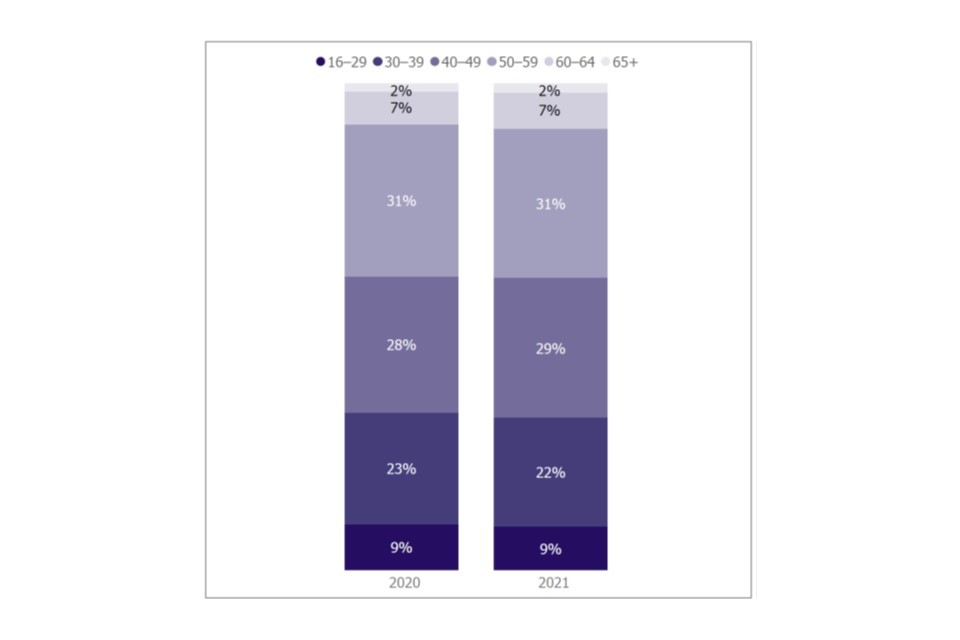
1. Percentages are rounded and may not add to 100.
2. Percentages calculated with less than 5 individuals are not shown in this table.
View data in an accessible table format.
Figure 2: Age profile of contracted Ofsted Inspectors
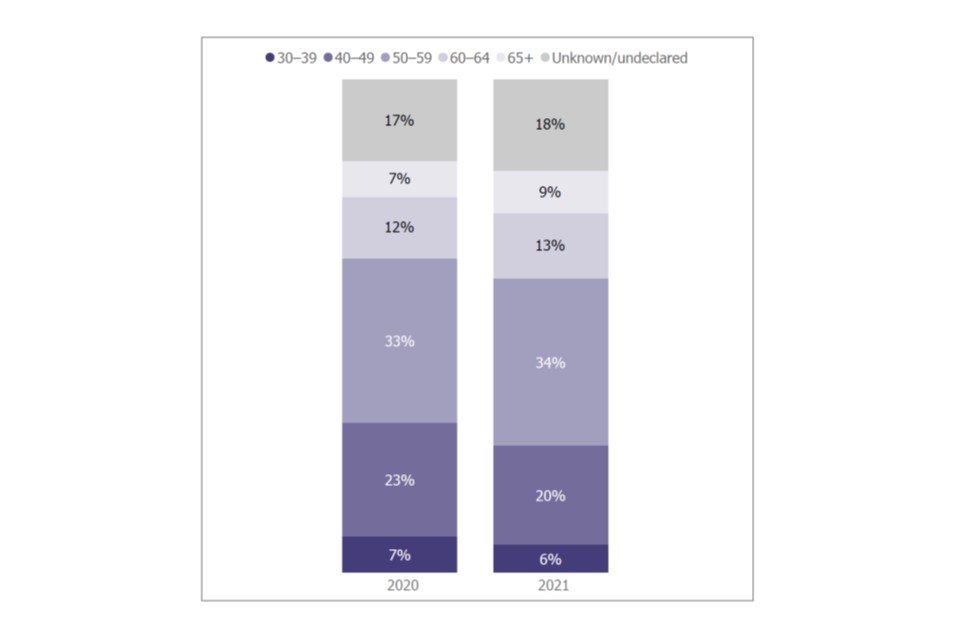
1. Percentages are rounded and may not add to 100.
2. Percentages calculated with less than 5 individuals are not shown in this table.
View data in an accessible table format.
Disability
Figure 3: Disability profile of employees

1. Percentages are rounded and may not add to 100.
2. Percentages calculated with less than 5 individuals are not shown in this table.
View data in an accessible table format.
Figure 4: Disability profile of contracted Ofsted Inspectors
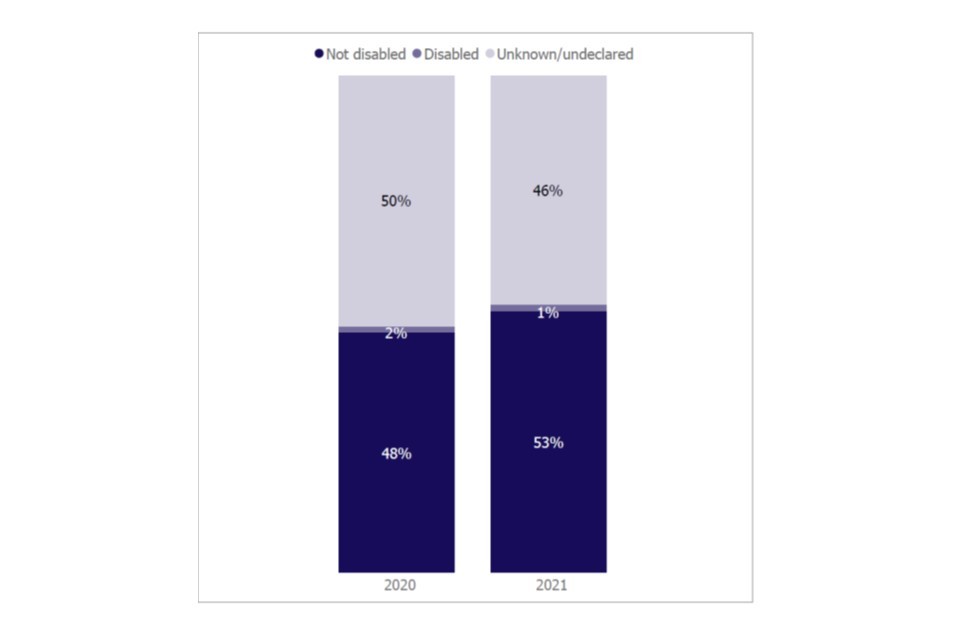
1. Percentages are rounded and may not add to 100.
2. Percentages calculated with less than 5 individuals are not shown in this table.
View data in an accessible table format.
Ethnicity
Figure 5: Ethnicity profile of employees
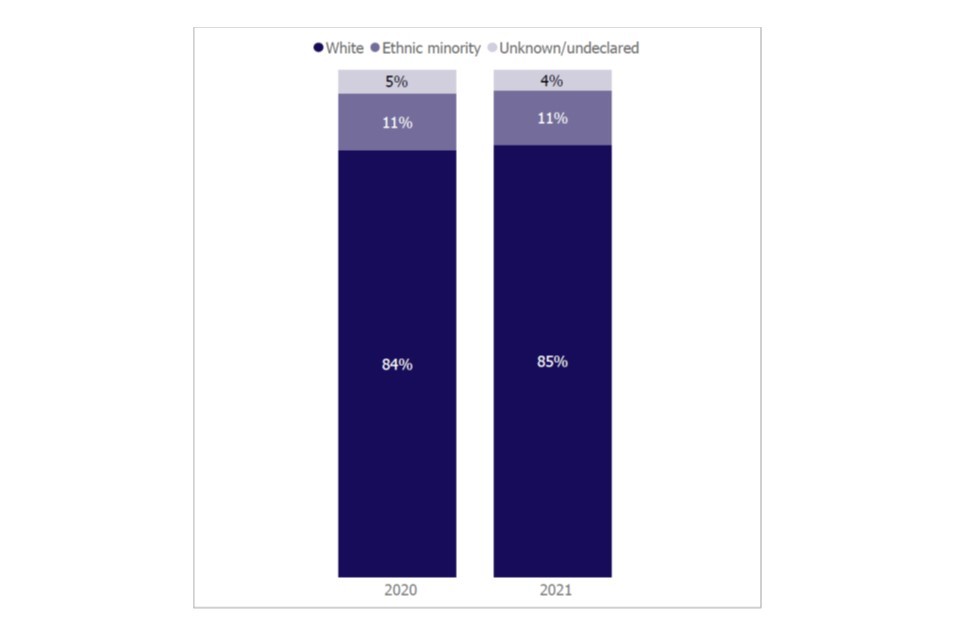
1. Percentages are rounded and may not add to 100.
2. Percentages calculated with less than 5 individuals are not shown in this table.
View data in an accessible table format.
Figure 6: Ethnicity profile of contracted Ofsted Inspectors
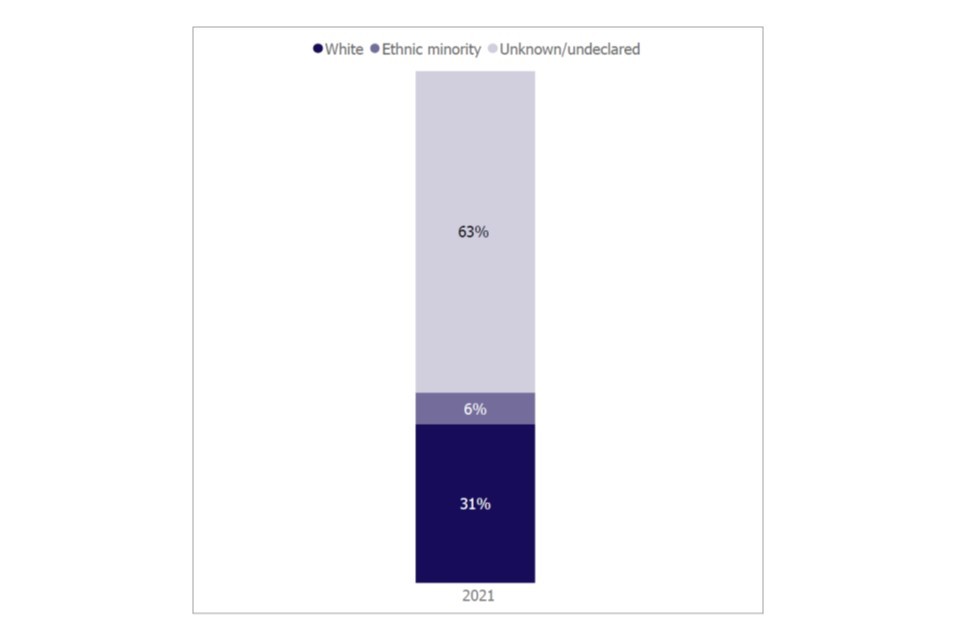
1. Percentages are rounded and may not add to 100.
2. Percentages calculated with less than 5 individuals are not shown in this table.
3. Note that ethnicity information was not reported for Ofsted Inspectors in 2020.
View data in an accessible table format.
Faith
Figure 7: Faith profile of employees
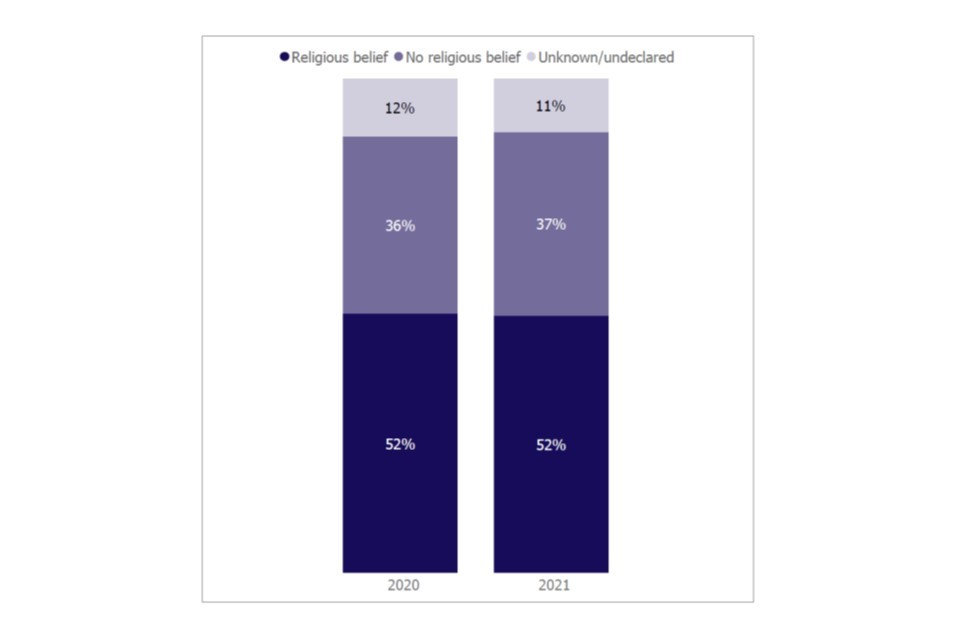
1. Percentages are rounded and may not add to 100.
2. Percentages calculated with less than 5 individuals are not shown in this table.
3. Buddhist, Christian, Jewish, Muslim, Sikh and Other included in the overall religious belief breakdown
View data in an accessible table format.
Figure 8: Faith profile of contracted Ofsted Inspectors
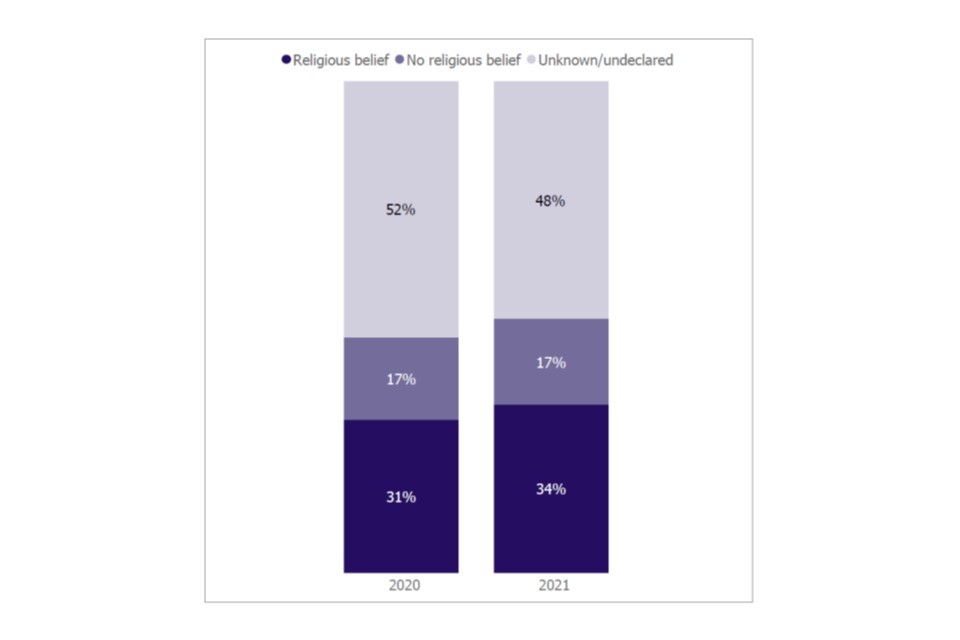
1. Percentages are rounded and may not add to 100.
2. Percentages calculated with less than 5 individuals are not shown in this table.
3. Buddhist, Christian, Jewish, Muslim, Sikh and Other included in the overall religious belief breakdown
View data in an accessible table format.
Sex
Figure 9: Sex profile of employees
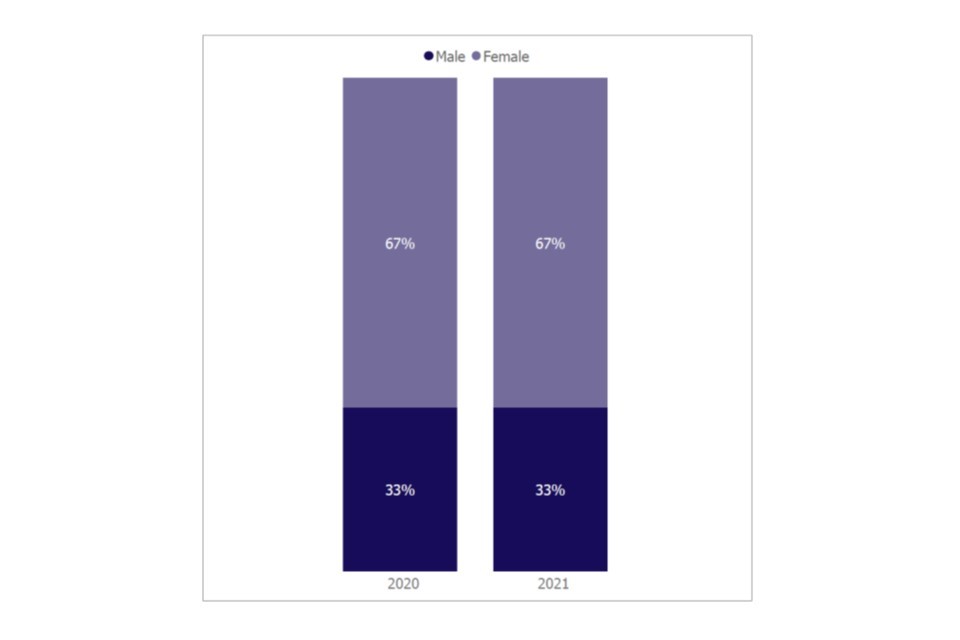
1. Percentages are rounded and may not add to 100.
2. Percentages calculated with less than 5 individuals are not shown in this table.
View data in an accessible table format.
Figure 10: Sex profile of contracted Ofsted Inspectors
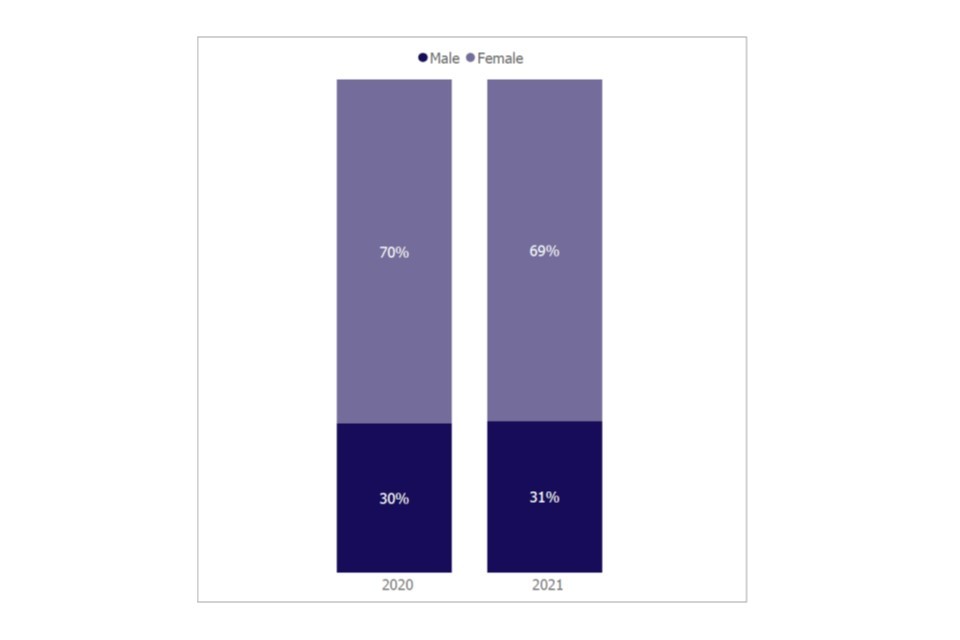
1. Percentages are rounded and may not add to 100.
2. Percentages calculated with less than 5 individuals are not shown in this table.
View data in an accessible table format.
Sexual orientation
Figure 11: Sexual orientation of employees
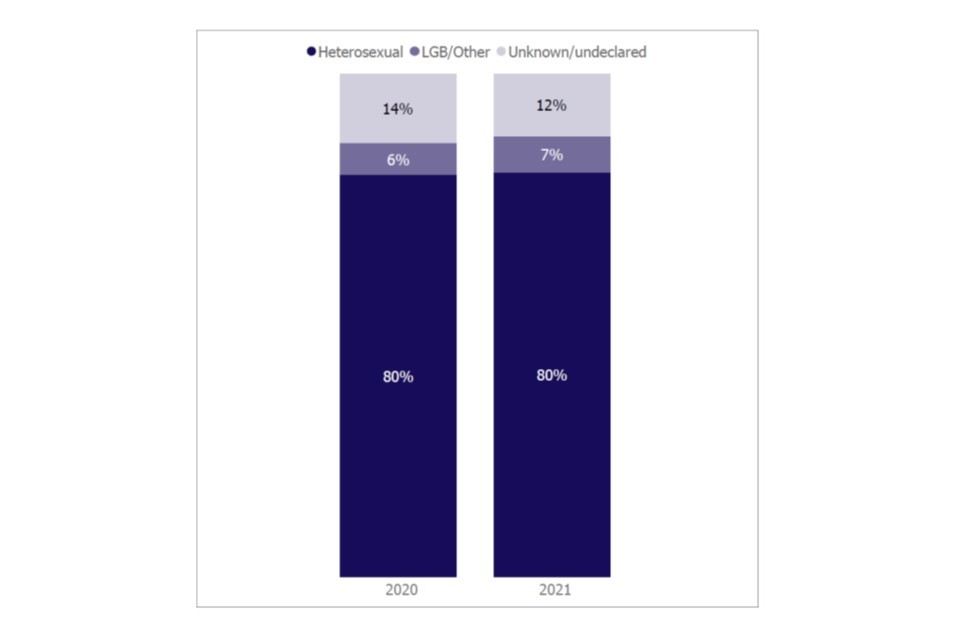
1. Percentages are rounded and may not add to 100.
2. Percentages calculated with less than 5 individuals are not shown in this table.
View data in an accessible table format.
Figure 12: Sexual orientation of contracted Ofsted Inspectors

1. Percentages are rounded and may not add to 100.
2. Percentages calculated with less than 5 individuals are not shown in this table.
View data in an accessible table format.
Annex A – Recruitment data
Figure 13: Applicant type at each stage of the recruitment process for inspector and SCS roles
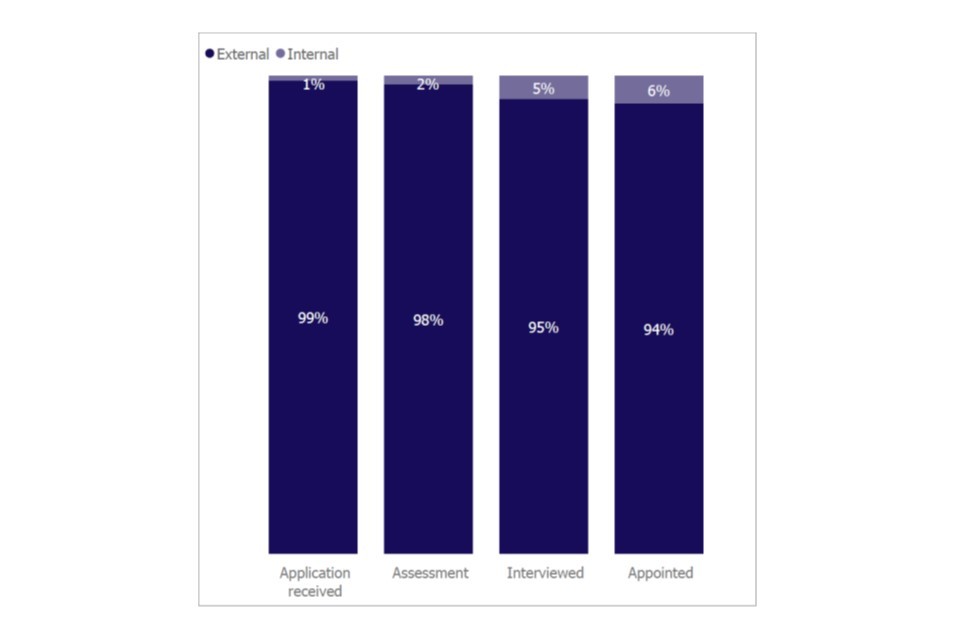
1. Percentages are rounded and may not add to 100.
2. Percentages calculated with less than 5 individuals are not shown in this table.
View data in an accessible table format.
Figure 14: Applicant type at each stage of the recruitment process for APT roles
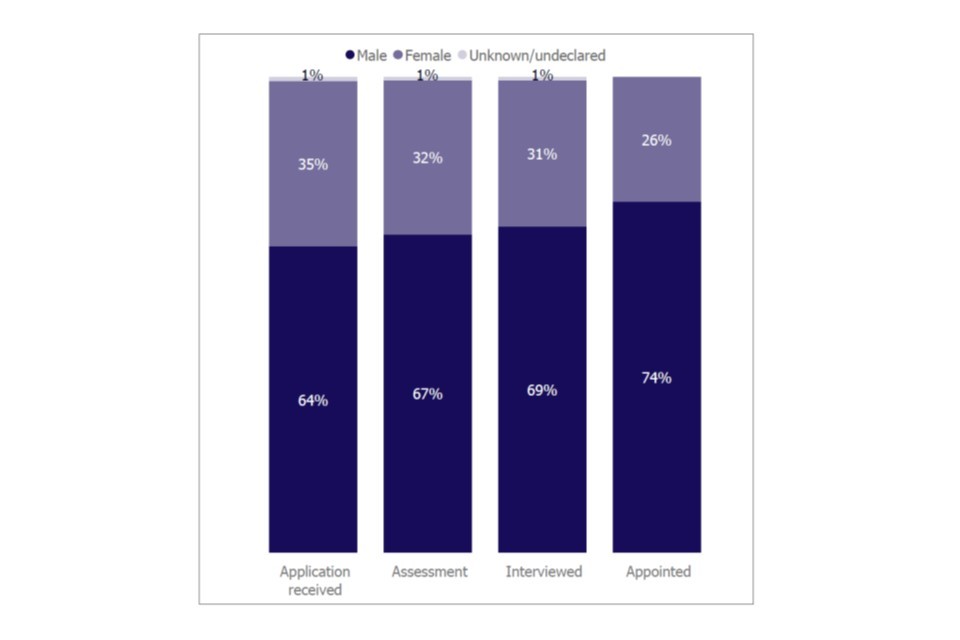
1. Percentages are rounded and may not add to 100.
2. Percentages calculated with less than 5 individuals are not shown in this table.
View data in an accessible table format.
Figure 15: Sex of applicants at each stage of the recruitment process for inspector and SCS roles

1. Percentages are rounded and may not add to 100.
2. Percentages calculated with less than 5 individuals are not shown in this table.
View data in an accessible table format.
Figure 16: Sex of applicants at each stage of the recruitment process for APT roles

1. Percentages are rounded and may not add to 100.
2. Percentages calculated with less than 5 individuals are not shown in this table.
View data in an accessible table format.
Figure 17: Disability declaration at each stage of the recruitment process for inspector and SCS roles
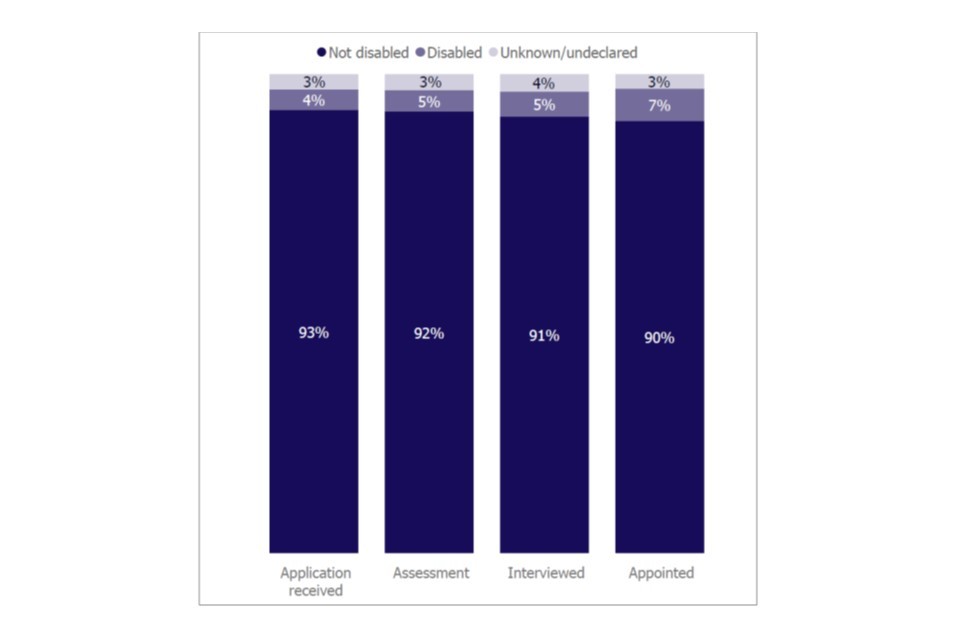
1. Percentages are rounded and may not add to 100.
2. Percentages calculated with less than 5 individuals are not shown in this table.
View data in an accessible table format.
Figure 18: Disability declaration at each stage of the recruitment process for APT roles

1. Percentages are rounded and may not add to 100.
2. Percentages calculated with less than 5 individuals are not shown in this table.
View data in an accessible table format.
Figure 19: Ethnicity of applicants at each stage of the recruitment process for inspector and SCS roles
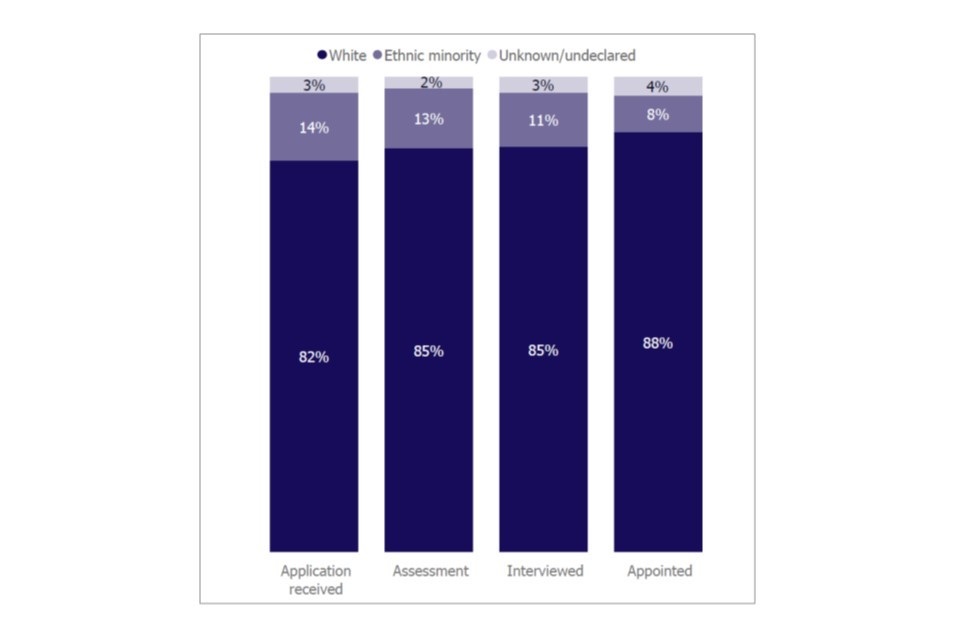
1. Percentages are rounded and may not add to 100.
2. Percentages calculated with less than 5 individuals are not shown in this table.
View data in an accessible table format.
Figure 20: Ethnicity of applicants at each stage of the recruitment process for APT roles
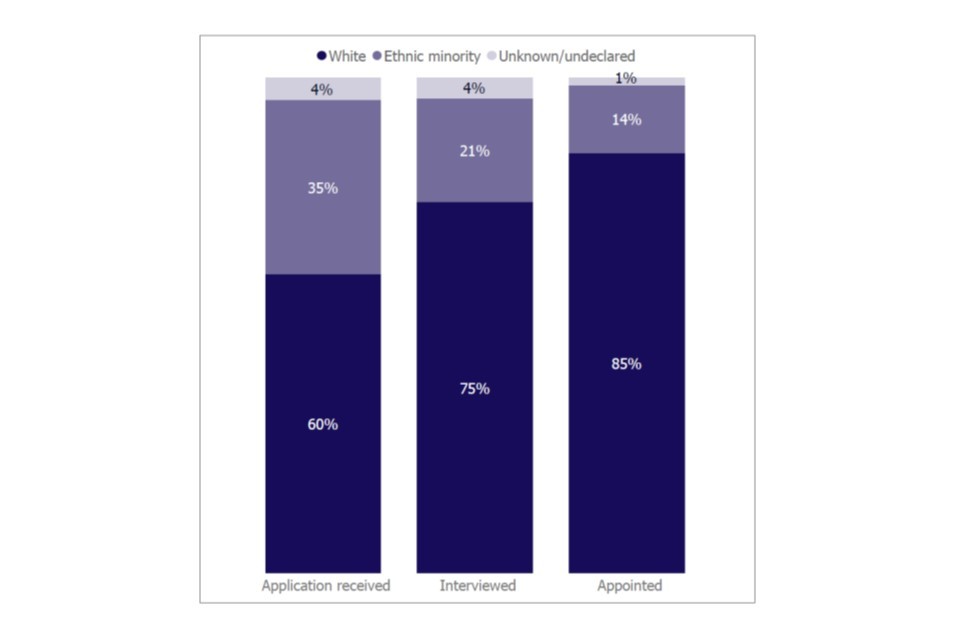
1. Percentages are rounded and may not add to 100.
2. Percentages calculated with less than 5 individuals are not shown in this table.
View data in an accessible table format.
Figure 21: Sexual orientation of applicants at each stage of the recruitment process for inspector and SCS roles

1. Percentages are rounded and may not add to 100.
2. Percentages calculated with less than 5 individuals are not shown in this table.
View data in an accessible table format.
Figure 22: Sexual orientation of applicants at each stage of the recruitment process for APT roles
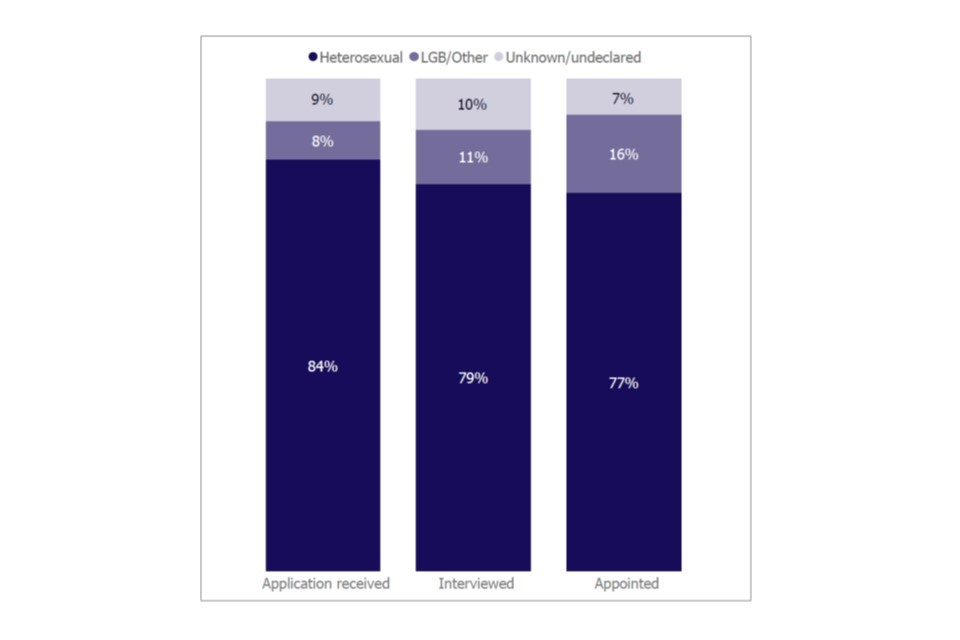
1. Percentages are rounded and may not add to 100.
2. Percentages calculated with less than 5 individuals are not shown in this table.
View data in an accessible table format.
Figure 23: Religious beliefs of applicants at each stage of the recruitment process for inspector and SCS roles
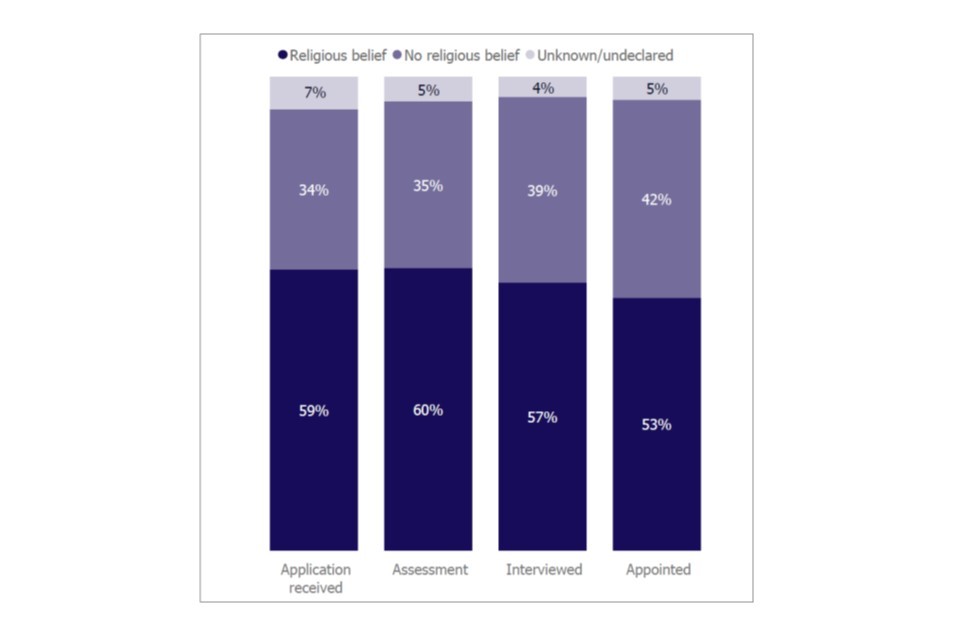
1. Percentages are rounded and may not add to 100.
2. Percentages calculated with less than 5 individuals are not shown in this table.
View data in an accessible table format.
Figure 24: Religious beliefs of applicants at each stage of the recruitment process for APT roles

1. Percentages are rounded and may not add to 100.
2. Percentages calculated with less than 5 individuals are not shown in this table.
View data in an accessible table format.
Annex B – Ofsted grade structure
Ofsted’s current grade structure broadly compares with the wider Civil Service grades.
APT job family:
- Senior Civil Service
- Principal Officer (Civil Service equivalent – Grade 6)
- Band A APT (Civil Service equivalent – Grade 7)
- B1 APT (Civil Service equivalent – Senior Executive Officer)
- B2 APT (Civil Service equivalent – Higher Executive Officer)
- B3 APT (Civil Service equivalent – Executive Officer)
- C1 APT (Civil Service equivalent – Administrative Officer)
Inspector job family:
- Senior Civil Service
- Senior HMI (Civil Service equivalent – Grade 6)
- HMI (Civil Service equivalent – Grade 7)
- Regulatory Inspection Manager (RIM) (Civil Service equivalent – Grade 7)
- B1 Inspector (Civil Service equivalent – Senior Executive Officer)
- B2 Inspector (Civil Service equivalent – Higher Executive Officer)
Data tables for figures
Data for Figure 1: Age profile of employees
| % in 2020 | % in 2021 | |
|---|---|---|
| 16 to 29 | 9 | 9 |
| 30 to 39 | 23 | 22 |
| 40 to 49 | 28 | 29 |
| 50 to 59 | 31 | 31 |
| 60 to 64 | 7 | 7 |
| 65+ | 2 | 2 |
1. Percentages are rounded and may not add to 100.
2. Percentages calculated with less than 5 individuals are not shown in this table.
See Figure 1
Data for Figure 2: Age profile of contracted Ofsted Inspectors
| % in 2020 | % in 2021 | |
|---|---|---|
| 30 to 39 | 7 | 6 |
| 40 to 49 | 23 | 20 |
| 50 to 59 | 33 | 34 |
| 60 to 64 | 12 | 13 |
| 65+ | 7 | 9 |
| Unknown/undeclared | 16 | 18 |
1. Percentages are rounded and may not add to 100.
2. Percentages calculated with less than 5 individuals are not shown in this table.
See Figure 2
Data for Figure 3: Disability profile of employees
| % in 2020 | % in 2021 | |
|---|---|---|
| Disabled | 6 | 8 |
| Not disabled | 84 | 83 |
| Unknown/undeclared | 10 | 10 |
1. Percentages are rounded and may not add to 100.
2. Percentages calculated with less than 5 individuals are not shown in this table.
See Figure 3
Data for Figure 4: Disability profile of contracted Ofsted Inspectors
| % in 2020 | % in 2021 | |
|---|---|---|
| Disabled | 1 | 1 |
| Not disabled | 48 | 53 |
| Unknown/undeclared | 50 | 46 |
1. Percentages are rounded and may not add to 100.
2. Percentages calculated with less than 5 individuals are not shown in this table.
See Figure 4
Data for Figure 5: Ethnicity profile of employees
| % in 2020 | % in 2021 | |
|---|---|---|
| White | 84 | 85 |
| Ethnic minority | 11 | 11 |
| Unknown/undeclared | 5 | 4 |
1. Percentages are rounded and may not add to 100.
2. Percentages calculated with less than 5 individuals are not shown in this table.
See Figure 5
Data for Figure 6: Ethnicity profile of contracted Ofsted Inspectors
| % in 2020 | % in 2021 | |
|---|---|---|
| White | N/A | 31 |
| Ethnic minority | N/A | 6 |
| Unknown/undeclared | N/A | 63 |
1. Percentages are rounded and may not add to 100.
2. Percentages calculated with less than 5 individuals are not shown in this table.
3. Note that ethnicity information was not reported for Ofsted Inspectors in 2020.
See Figure 6
Data for figure 7: Faith profile of employees
| % in 2020 | % in 2021 | |
|---|---|---|
| Religious belief | 52 | 52 |
| No religious belief | 36 | 37 |
| Unknown/undeclared | 12 | 11 |
1. Percentages are rounded and may not add to 100.
2. Percentages calculated with less than 5 individuals are not shown in this table.
3. Buddhist, Christian, Jewish, Muslim, Sikh and Other included in the overall religious belief breakdown
See Figure 7
Data for figure 8: Faith profile of contracted Ofsted Inspectors
| % in 2020 | % in 2021 | |
|---|---|---|
| Religious belief | 31 | 34 |
| No religious belief | 17 | 17 |
| Unknown/undeclared | 52 | 48 |
1. Percentages are rounded and may not add to 100.
2. Percentages calculated with less than 5 individuals are not shown in this table.
3. Buddhist, Christian, Jewish, Muslim, Sikh and Other are included in the overall religious belief breakdown.
See Figure 8
Data for Figure 9: Sex profile of employees
| % in 2020 | % in 2021 | |
|---|---|---|
| Male | 33 | 33 |
| Female | 67 | 67 |
1. Percentages are rounded and may not add to 100.
2. Percentages calculated with less than 5 individuals are not shown in this table.
See Figure 9
Data for Figure 10: Sex profile of contracted Ofsted Inspectors
| % in 2020 | % in 2021 | |
|---|---|---|
| Male | 30 | 31 |
| Female | 70 | 69 |
1. Percentages are rounded and may not add to 100.
2. Percentages calculated with less than 5 individuals are not shown in this table.
See Figure 10
Sexual orientation
Data for Figure 11: Sexual orientation of employees
| % in 2020 | % in 2021 | |
|---|---|---|
| Heterosexual | 80 | 80 |
| LGB/Other | 6 | 7 |
| Unknown/undeclared | 14 | 12 |
1. Percentages are rounded and may not add to 100.
2. Percentages calculated with less than 5 individuals are not shown in this table.
See Figure 11
Data for Figure 12: Sexual orientation of contracted Ofsted Inspectors
| % in 2020 | % in 2021 | |
|---|---|---|
| Heterosexual | 45 | 49 |
| LGB/Other | 3 | 3 |
| Unknown/undeclared | 52 | 48 |
1. Percentages are rounded and may not add to 100.
2. Percentages calculated with less than 5 individuals are not shown in this table.
See Figure 12
Data for Figure 13: Applicant type at each stage of the recruitment process for inspector and SCS roles
| External | Internal | |
|---|---|---|
| Application received | 99 | 1 |
| Assessment | 98 | 2 |
| Interviewed | 95 | 5 |
| Appointed | 94 | 6 |
1. Percentages are rounded and may not add to 100.
2. Percentages calculated with less than 5 individuals are not shown in this table.
See Figure 13
Data for Figure 14: Applicant type at each stage of the recruitment process for APT roles
| Internal to Ofsted | Wider Civil Service | External | |
|---|---|---|---|
| Application received | 5 | 12 | 82 |
| Interviewed | 25 | 20 | 55 |
| Appointed | 49 | 13 | 38 |
1. Percentages are rounded and may not add to 100.
2. Percentages calculated with less than 5 individuals are not shown in this table.
See Figure 14
Data for Figure 15: Sex of applicants at each stage of the recruitment process for inspector and SCS roles
| Male | Female | Unknown/undeclared | |
|---|---|---|---|
| Application received | 35 | 64 | 1 |
| Assessment | 32 | 67 | 1 |
| Interviewed | 31 | 69 | 1 |
| Appointed | 26 | 74 | 0 |
1. Percentages are rounded and may not add to 100.
2. Percentages calculated with less than 5 individuals are not shown in this table.
See Figure 15
Data for Figure 16: Sex of applicants at each stage of the recruitment process for APT roles
| Male | Female | Unknown/undeclared | |
|---|---|---|---|
| Application received | 38 | 60 | 2 |
| Interviewed | 37 | 60 | 3 |
| Appointed | 39 | 59 | 1 |
1. Percentages are rounded and may not add to 100.
2. Percentages calculated with less than 5 individuals are not shown in this table.
See Figure 16
Data for Figure 17: Disability declaration at each stage of the recruitment process for inspector and SCS roles
| Not disabled | Disabled | Unknown/undeclared | |
|---|---|---|---|
| Application received | 93 | 4 | 3 |
| Assessment | 92 | 5 | 3 |
| Interviewed | 91 | 5 | 4 |
| Appointed | 90 | 7 | 3 |
1. Percentages are rounded and may not add to 100.
2. Percentages calculated with less than 5 individuals are not shown in this table.
See Figure 17
Data for Figure 18: Disability declaration at each stage of the recruitment process for APT roles
| Not disabled | Disabled | Unknown/undeclared | |
|---|---|---|---|
| Application received | 88 | 9 | 4 |
| Interviewed | 84 | 13 | 3 |
| Appointed | 90 | 8 | 2 |
1. Percentages are rounded and may not add to 100.
2. Percentages calculated with less than 5 individuals are not shown in this table.
See Figure 18
Data for Figure 19: Ethnicity of applicants at each stage of the recruitment process for inspector and SCS roles
| White | Ethnic minority | Unknown/undeclared | |
|---|---|---|---|
| Application received | 82 | 14 | 3 |
| Assessment | 85 | 13 | 2 |
| Interviewed | 85 | 11 | 3 |
| Appointed | 88 | 8 | 4 |
1. Percentages are rounded and may not add to 100.
2. Percentages calculated with less than 5 individuals are not shown in this table.
See Figure 19
Data for Figure 20: Ethnicity of applicants at each stage of the recruitment process for APT roles
| White | Ethnic minority | Unknown/undeclared | |
|---|---|---|---|
| Application received | 60 | 35 | 4 |
| Interviewed | 75 | 21 | 4 |
| Appointed | 85 | 14 | 1 |
1. Percentages are rounded and may not add to 100.
2. Percentages calculated with less than 5 individuals are not shown in this table.
See Figure 20
Data for Figure 21: Sexual orientation of applicants at each stage of the recruitment process for inspector and SCS roles
| Heterosexual | LGB/Other | Unknown/undeclared | |
|---|---|---|---|
| Application received | 88 | 6 | 6 |
| Assessment | 89 | 6 | 4 |
| Interviewed | 89 | 7 | 4 |
| Appointed | 88 | 10 | 2 |
1. Percentages are rounded and may not add to 100.
2. Percentages calculated with less than 5 individuals are not shown in this table.
See Figure 21
Data for Figure 22: Sexual orientation of applicants at each stage of the recruitment process for APT roles
| Heterosexual | LGB/Other | Unknown/undeclared | |
|---|---|---|---|
| Application received | 84 | 8 | 9 |
| Interviewed | 79 | 11 | 10 |
| Appointed | 77 | 16 | 7 |
1. Percentages are rounded and may not add to 100.
2. Percentages calculated with less than 5 individuals are not shown in this table.
See Figure 22
Data for Figure 23: Religious beliefs of applicants at each stage of the recruitment process for inspector and SCS roles
| Religious belief | No Religious belief | Unknown/undeclared | |
|---|---|---|---|
| Application received | 59 | 34 | 7 |
| Assessment | 60 | 35 | 5 |
| Interviewed | 57 | 39 | 4 |
| Appointed | 53 | 42 | 5 |
1. Percentages are rounded and may not add to 100.
2. Percentages calculated with less than 5 individuals are not shown in this table.
See Figure 23
Data for Figure 24: Religious beliefs of applicants at each stage of the recruitment process for APT roles
| Religious belief | No religious belief | Unknown/undeclared | |
|---|---|---|---|
| Application received | 56 | 42 | 2 |
| Interviewed | 48 | 51 | 2 |
| Appointed | 46 | 54 | 0 |
1. Percentages are rounded and may not add to 100.
2. Percentages calculated with less than 5 individuals are not shown in this table.
See Figure 24.

